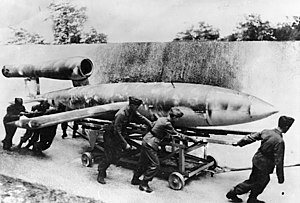V-1 flying bomb
| V-1 flying bomb Fieseler Fi 103 Flakzielgerät 76 (FZG-76) |
|
|---|---|
 |
|
| Type | Guided missile |
| Place of origin | Nazi Germany |
| Service history | |
| In service | 1944–1945 |
| Used by | Luftwaffe |
| Wars | World War II |
| Production history | |
| Designer | Robert Lusser |
| Manufacturer | Fieseler |
| Unit cost | 5,090 RM |
| Specifications | |
| Weight | 2,150 kg (4,740 lb) |
| Length | 8.32 m (27.3 ft) |
| Width | 5.37 m (17.6 ft) |
| Height | 1.42 m (4 ft 8 in) |
|
|
|
| Warhead | Amatol-39 |
| Warhead weight | 850 kg (1,870 lb) |
|
|
|
| Engine | Argus As 109-014 Pulsejet |
|
Operational
range |
250 km (160 mi) |
| Speed | 640 km/h (400 mph) flying between 600 to 900 m (2,000 to 3,000 ft) |
|
Guidance
system |
Gyrocompass based autopilot |
The V-1 missile or V-1 flying bomb (German: Vergeltungswaffe 1 "Vengeance Weapon 1")—also known to the Allies as the buzz bomb, or doodlebug, and in Germany as Kirschkern (cherrystone) or Maikäfer (maybug)—was an early cruise missile and the first production aircraft to use a pulsejet for power.
The V-1 was developed at Peenemünde Army Research Center by the Nazi German Luftwaffe during the Second World War. During initial development it was known by the codename "Cherry Stone". The first of the so-called "Vengeance weapons" (V-weapons or Vergeltungswaffen) series designed for terror bombing of London — because of its limited range, the thousands of V-1 missiles launched into England were fired from launch facilities along the French (Pas-de-Calais) and Dutch coasts. The first V-1 was launched at London on 13 June 1944), one week after (and prompted by) the successful Allied landings in Europe. At its peak, more than one hundred V-1s a day were fired at south-east England, 9,521 in total, decreasing in number as sites were overrun until October 1944, when the last V-1 site in range of Britain was overrun by Allied forces. After this, the V-1s were directed at the port of Antwerp and other targets in Belgium, with 2,448 V-1s being launched. The attacks stopped only a month before the war in Europe ended, when the last launch site in the Low Countries was overrun on 29 March 1945.
The British operated an arrangement of air defences, including anti-aircraft guns and fighter aircraft, to intercept the bombs before they reached their targets as part of Operation Crossbow, while the launch sites and underground V-1 storage depots were targets of strategic bombing.
...
Wikipedia
